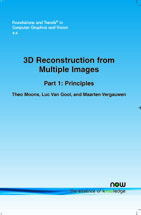3D Reconstruction from Multiple Images Part 1: Principles
By Theo Moons, Hogeschool — Universiteit Brussel, Belgium, Theo.Moons@hubrussel.be | Luc Van Gool, Katholieke Universiteit Leuven, ESAT — PSI, Belgium and ETH Zurich, BIWI, Switzerland, Luc.VanGool@esat.kuleuven.be | Maarten Vergauwen, GeoAutomation NV, Belgium, maarten.vergauwen@geoautomation.comy
Abstract
This issue discusses methods to extract three-dimensional (3D) models from plain images. In particular, the 3D information is obtained from images for which the camera parameters are unknown. The principles underlying such uncalibrated structure-from-motion methods are outlined. First, a short review of 3D acquisition technologies puts such methods in a wider context and highlights their important advantages. Then, the actual theory behind this line of research is given. The authors have tried to keep the text maximally self-contained, therefore also avoiding to rely on an extensive knowledge of the projective concepts that usually appear in texts about self-calibration 3D methods. Rather, mathematical explanations that are more amenable to intuition are given. The explanation of the theory includes the stratification of reconstructions obtained from image pairs as well as metric reconstruction on the basis of more than two images combined with some additional knowledge about the cameras used. Readers who want to obtain more practical information about how to implement such uncalibrated structure-from-motion pipelines may be interested in two more Foundations and Trends issues written by the same authors. Together with this issue they can be read as a single tutorial on the subject.
3D Reconstruction from Multiple Images
3D Reconstruction from Multiple Images, Part 1: Principles discusses and explains methods to extract 3-dimensional (3D) models from plain images. In particular, the 3D information is obtained from images for which the camera parameters are unknown. The principles underlying such uncalibrated structure-from-motion methods are outlined. First, a short review of 3D acquisition technologies puts such methods in a wider context, and highlights their important advantages. Then, the actual theory behind this line of research is given. The authors have tried to keep the text maximally self-contained, therefore also avoiding relying on an extensive knowledge of the projective concepts that usually appear in texts about self-calibration 3D methods. Rather, mathematical explanations that are more amenable to intuition are given. The explanation of the theory includes the stratification of reconstructions obtained from image pairs as well as metric reconstruction on the basis of more than 2 images combined with some additional knowledge about the cameras used.
3D Reconstruction from Multiple Images, Part 1: Principles is the first of a 3-part Foundations and Trends tutorial on this topic written by the same authors. Part II will focus on more practical information about how to implement such uncalibrated structure-from-motion pipelines, while Part III will outline an example pipeline with further implementation issues specific to this particular case, and including a user guide.
